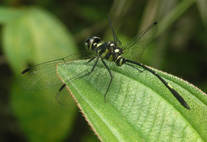Abstract
The complete mitochondrial (mt) genomes of two Oriental endemic dobsonfly species, Neoneuromus tonkinensis (van der Weele) and Nevromus exterior (Navás), were determined and analyzed, which represent the first mt genomes of the genera Neoneuromus van der Weele, 1909 and Nevromus Rambur, 1842. The mt genome of N. tonkinensis is a typical circular DNA of 15776 bp with A+T content being 76.3%, while that of N. exterior is 15763 bp with A+T content being 77.5%. Both mt genomes are composed of 37 genes with an ancestral gene arrangement of the insect mt genome. Eleven of the 13 protein coding genes (PCGs) start with codon ATT and ATG, except for cox1 and nad1 respectively having ATC and ATA as the start codons in the mt genome of N. tonkinensis. Complete termination codons TAG and TAA were found in nine PCGs, while the remaining four genes are supposed to end with a single T. Most tRNAs are folded into the typical clover-leaf structure except for the trnS1 whose dihydrouridine arm is a simple loop. The secondary structure of rrnL consists of five structural domains and 50 helices, while the rrnS includes three domains and 34 helices. In the phylogenomic analysis, both Bayesian inference (BI) and maximum likelihood (ML) approaches, based on sequence data of all 13 PCGs and two rRNA genes of the mt genomes, suggested that Neoneuromus and Nevromus form a monophyletic group, which is the sister group of the lineage including Corydalus and Acanthacorydalis but not the sister group of Acanthacorydalis van der Weele, 1907 as previously reported based on morphological data.

